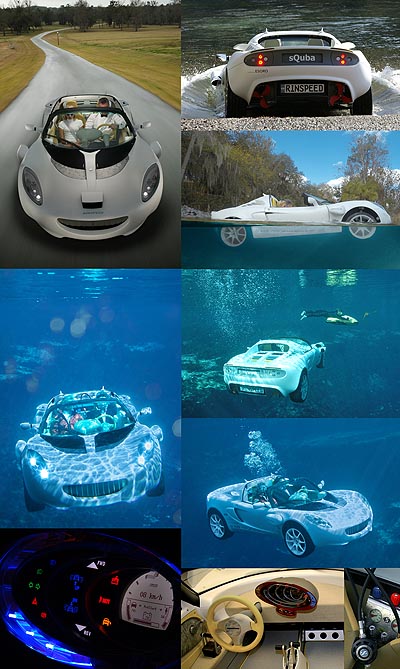« The Dive Computer Blues | Main | I feel like a total scuba failure »
February 15, 2008
The submersible Rinspeed sQuba car
Back in 1977, in the James Bond Movie "The Spy Who Loved Me," Roger Moore's agent 007 had a very special Series 1 Lotus Esprit that converted from a sports car to a submarine. The Lotus had propellers and rudders and even a battery of harpoon launchers to help Bond fight off the bad guys.  The submarine Lotus was more than just a prop; it did go underwater and the rudder and propellers worked. However, it wasn't actually water-tight, and so a stuntman with Scuba gear operated it inside behind the dark glass. The picture to the right shows a scale model of the submersible Lotus.
The submarine Lotus was more than just a prop; it did go underwater and the rudder and propellers worked. However, it wasn't actually water-tight, and so a stuntman with Scuba gear operated it inside behind the dark glass. The picture to the right shows a scale model of the submersible Lotus.
Well, now there is a real diving Lotus. Rinspeed, a Swiss tuner and builder of exotic concept cars and other futuristic vehicles built the Rinspeed sQuba, a drivable, divable concept car that really works. Based on a Lotus Elise, the electric-powered sQuba is the brainchild of Rinspeed founder Frank M. Rinderknecht, who never forgot that submersible car from the James Bond movie. “For three decades I have tried to imagine how it might be possible to build a car that can fly under water. Now we have made this dream come true,†Rinderknecht said.
How did they do it? First, there had to be some practical thinking. For example, even though the Lotus Elise is a very small car (only about 150 inches long), the enclosed volume of about 70 cubic feet would have required adding 4,400 pounds of weight. The necessary ballast tanks would have made for a large, bulky vehicle that didn't look anything like a sleek sports car. So Rinspeed decided to build the sQuba as an open vehicle with its passengers using built-in scuba gear while underwater. The car floats on water, then sinks when the doors are opened and water enters the car. However, without passengers it surfaces on its own.
 What all did Rinspeed do to make this possible? Well, they removed the combustion engine and replaced it with a variety of electrical motors. For operation on land, the main electric motor makes 73 horsepower and 118 foot-pounds of torque at 4500 rpm. Rinspeed estimates the top speed to be "over 75 mph," but given the weight (less than 2,000 pounds) and power it's probaby over 100 mph. Floating in water, the sQuba uses two propellers in the back, powered by an 800 Watt electric motor each, good for a speed of about four knots. Underwater, propulsion is via two electric 5-horsepower Seabob jet drives that breathe through rotating louvers and expell the water through light but twist-resistant Carbon "nano tubes." That gives the sQuba an underwater speed of about two knots. Power is supplied by rechargeable Lithium Ion batteries. Rinspeed states "the sQuba's filling station is the water reservoir,†referring to the electric hydropower the Swiss are experts in. Operating diving depth is around 33 feet.
What all did Rinspeed do to make this possible? Well, they removed the combustion engine and replaced it with a variety of electrical motors. For operation on land, the main electric motor makes 73 horsepower and 118 foot-pounds of torque at 4500 rpm. Rinspeed estimates the top speed to be "over 75 mph," but given the weight (less than 2,000 pounds) and power it's probaby over 100 mph. Floating in water, the sQuba uses two propellers in the back, powered by an 800 Watt electric motor each, good for a speed of about four knots. Underwater, propulsion is via two electric 5-horsepower Seabob jet drives that breathe through rotating louvers and expell the water through light but twist-resistant Carbon "nano tubes." That gives the sQuba an underwater speed of about two knots. Power is supplied by rechargeable Lithium Ion batteries. Rinspeed states "the sQuba's filling station is the water reservoir,†referring to the electric hydropower the Swiss are experts in. Operating diving depth is around 33 feet.
When going under, the car's occupants use an integrated air supply system with two gas tanks -- one 15 liters, the other 18 liters -- and Scubapro regulators, specifically Scubapro's classic and very reliable air-balanced G250V second stage. The Scubapro gear and the tanks are mounted behind the passengers.
The sQuba is chuck full of interesting technology, and not only for underwater operation. On land, it uses a laser scanner system to essentially drive itself. For underwater operation, Rinspeed and its partners designed a cockpit and instruments that's inspired by the elegant shape and lines of a Manta Ray. Individual instruments seem to float and have dials that are lined up like lenses. The main control cluster is futuristically lighted and sits behind a protective sheet of glass with a fisheye effect. Controls can be operated even with diving gloves.
How real is the Rinspeed sQuba? Real enough for an impressive video of its operation on land, floating and diving. You can see the movie as well as pictures on Rinspeed's website. It works. But it's also a concept and not meant for production at all. For that, it'd need a more powerful motor, and the market for diving cars is likely very small. But none of that matters. Concepts are limited only by the imagination. "For three decades I have tried to imagine how it might be possible to build a car that can fly under water," said Frank Rinderknecht. "Now we have made this dream come true.†Very cool.
Posted by conradb212 at February 15, 2008 12:37 AM








